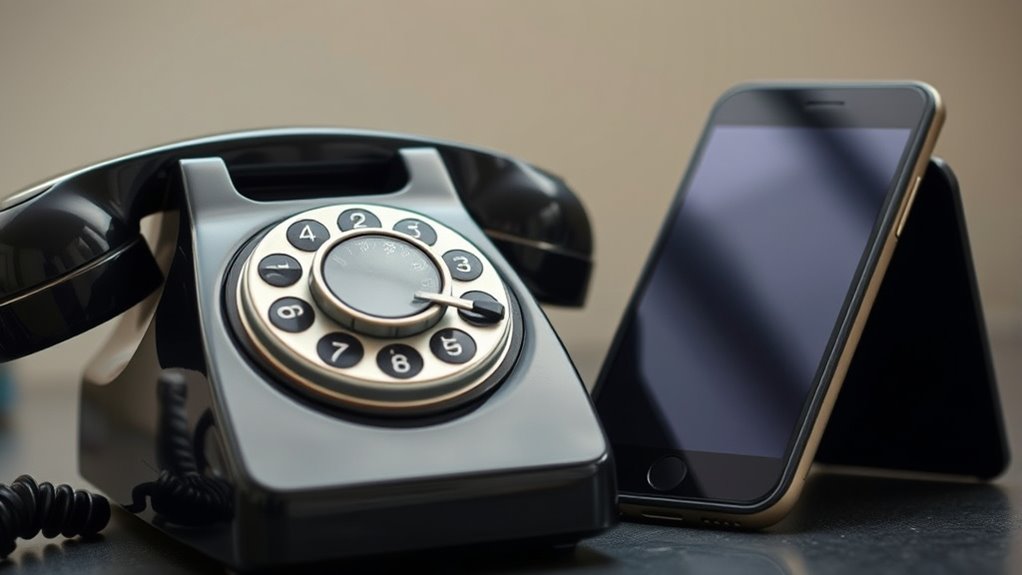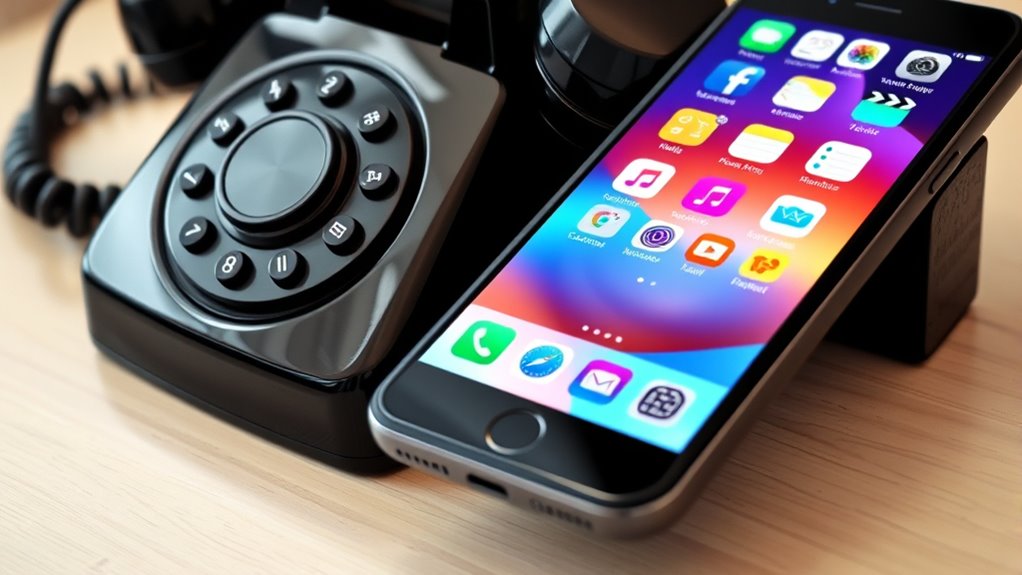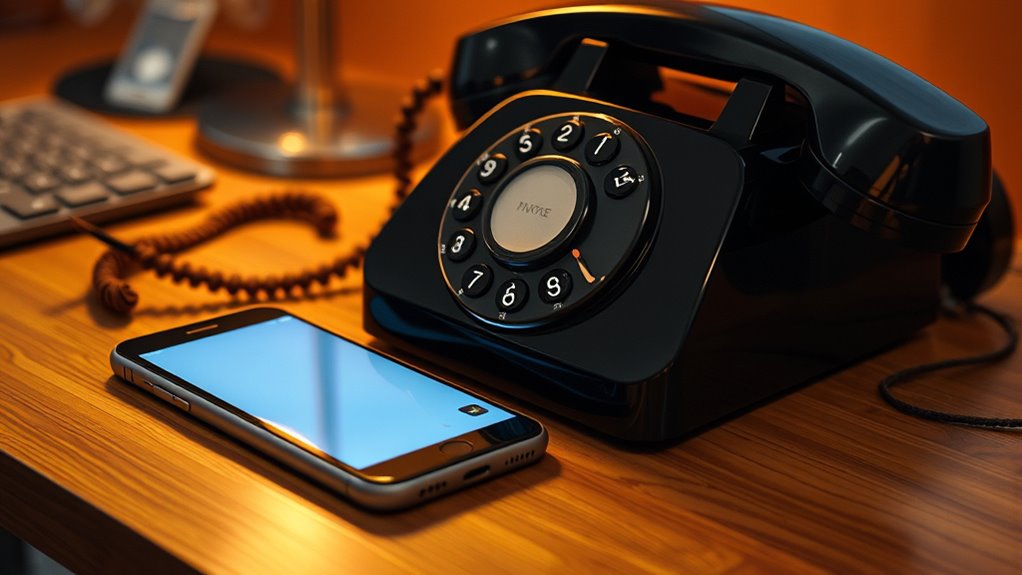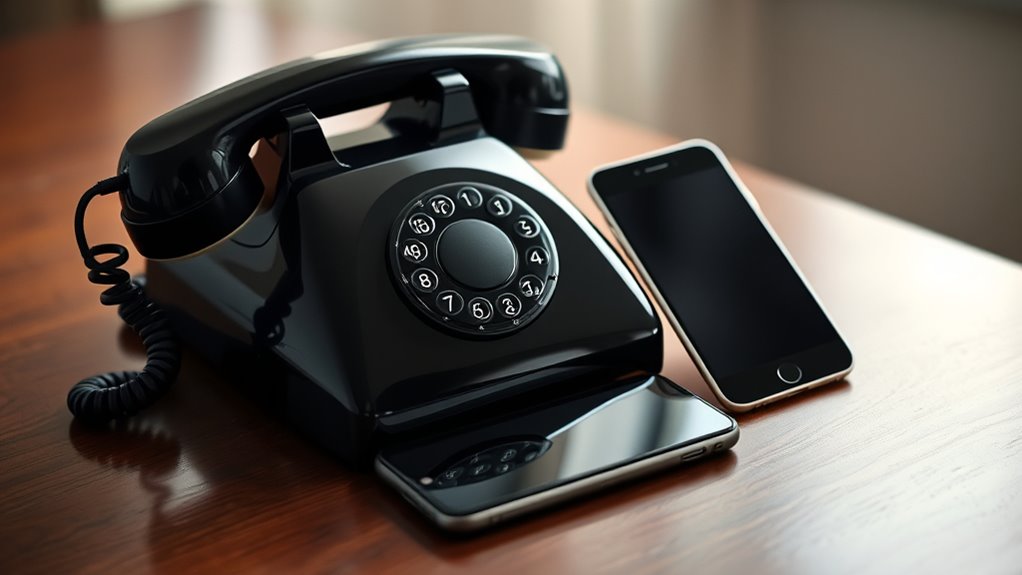From rotary phones to smartphones, the journey involves many surprising tech innovations. You move from mechanical rotary dials to push-button phones, then to touch-tone keypads for faster dialing. Wireless and mobile tech introduced cordless phones and early mobile devices. Eventually, smartphones combined internet, multimedia, and advanced operating systems into one sleek, multifunctional device. If you keep exploring, you’ll uncover more surprising steps that made modern communication so effortless.
Key Takeaways
- Mechanical rotary dials evolved into push-button keypads, improving dialing speed and aesthetics.
- Digital and electronic systems introduced touch-tone technology, enabling rapid, reliable number transmission.
- Wireless and mobile innovations transitioned phones from wired landlines to portable devices with cellular connectivity.
- Early smartphones integrated digital communication with computing features, bridging traditional phones to advanced digital devices.
- Modern smartphones combine multimedia, internet, and voice recognition, reflecting a continuous evolution from mechanical to digital technology.
The Transition From Mechanical to Electronic Dialing

The shift from mechanical to electronic dialing marked a significant change in telephone technology. You might notice how early phones relied on rotary dials that used analog circuitry to send electrical pulses corresponding to each number. This method was simple but slow, requiring you to rotate the dial for every digit. With electronic dialing, voice recognition technology began to emerge, enabling users to dial numbers verbally instead of turning dials. This progression improved speed and convenience, reducing the mechanical parts involved. As circuits became more sophisticated, electronic systems replaced the bulky mechanical components, paving the way for future innovations. Self Watering Plant Pots are a modern example of how technology has evolved to improve plant care, making watering more efficient and less labor-intensive. This era marked the beginning of a move toward more automated, user-friendly phones, setting the foundation for the push-button and digital systems to come.
The Birth of the Push-Button Telephone

As electronic systems advanced, manufacturers sought a more efficient way for users to dial numbers, leading to the development of push-button telephones. This innovation improved dialing comfort and replaced the rotary design with quick, tactile buttons. You could now:
As technology advanced, push-button phones replaced rotary dials for faster, easier, and more comfortable dialing.
- Dial numbers faster than with rotary mechanisms
- Reduce errors with clear, individual buttons
- Enjoy minimal physical effort during dialing
- Benefit from a sleek, modern appearance
- AI Ethical considerations began to influence the design and regulation of new communication technologies.
Push-button phones marked a significant shift from rotary design, making calls easier and more reliable. They introduced a new level of convenience, paving the way for future technological advancements. This evolution responded directly to user needs for efficiency and comfort, transforming the way we connect over the phone.
The Development of Touch-Tone Technology

Building on the convenience of push-button phones, engineers sought an even faster and more reliable way to dial numbers. They developed touch-tone technology, which used dual-tone multi-frequency (DTMF) signals to transmit each key press. This innovation allowed for quicker dialing and improved call routing. As technology advanced, voice recognition emerged, enabling you to dial numbers or execute commands simply by speaking. To enhance user experience, haptic feedback was added, providing tactile confirmation with subtle vibrations when you press a button or speak commands. This combination of sound, touch, and speech recognition made phone interactions more intuitive and efficient. Touch-tone technology laid the groundwork for modern voice-controlled systems, bridging the gap between manual dialing and fully automated voice assistants. AI-powered systems continue to enhance user interaction with telecommunication devices, building on these foundational innovations.
The Rise of the Cordless Phone

Have you ever wondered how phones became less tethered to walls and more portable? The rise of the cordless phone revolutionized communication by offering cordless convenience and wireless freedom. This innovation allowed you to move around freely while on a call. Here’s how it happened:
- The invention of the cordless phone in the 1980s introduced a base station connected to the landline.
- You could then walk around your home without being glued to the cord.
- Improved technology increased range, making cordless phones practical for most households.
- This shift made phone use more flexible, setting the stage for mobile phones.
- As technology advanced, security measures such as encryption were implemented to protect conversations over wireless networks.
The cordless phone marked a significant step toward the wireless devices we rely on today, blending the familiarity of landlines with newfound mobility.
The Emergence of First Mobile Phones

The first mobile phones emerged in the 1980s, transforming communication by making it truly portable. These early devices relied on cellular networks, allowing you to make calls without being tied to a landline. Although bulky and expensive, they marked a major leap forward, especially for emergency situations. Satellite communication played a role in expanding coverage to remote areas, ensuring you’re reachable even off the grid. Mobile phones also enabled emergency broadcasts, quickly disseminating vital information during crises. While limited in features compared to today’s smartphones, these devices gave you a new level of freedom and immediacy in communication. You could now stay connected on the go, knowing help was just a call away, no matter where you were. Advances in wireless technology continue to shape how we connect across diverse environments.
The Introduction of the Smartphone’s Early Models

As technology advanced in the late 1990s and early 2000s, manufacturers introduced the first smartphones, combining mobile calling capabilities with basic computing features. These early models marked a shift from traditional analog signals and rotary dial phones, offering more advanced communication options. You might recall that these phones used digital signals, enabling data transfer and internet access. Here’s what made them stand out:
Early smartphones combined calling with basic computing and digital signals, transforming communication.
- They integrated PDA functions like calendars and contacts.
- They replaced rotary dials with keypad input.
- They used analog signals initially but shift to digital.
- They introduced basic apps and email capabilities.
These innovations set the stage for the smartphones you use today, bridging the gap between classic phones and modern devices.
The Impact of Touchscreens and Mobile Operating Systems

Touchscreens and mobile operating systems revolutionized smartphones by making them more intuitive and versatile. You can now navigate with simple gestures, and features like voice recognition enable hands-free commands. Haptic feedback adds a tactile experience, confirming actions with subtle vibrations. These advancements allow you to interact naturally, blending technology seamlessly into daily life. Additionally, understanding nutritional advantages of juice features can enhance your health routines.
The Integration of Internet and Multimedia Capabilities

Integrating internet and multimedia capabilities transformed smartphones into powerful all-in-one devices. Now, you can do much more than make calls. Consider these key features:
Smartphones now serve as all-in-one multimedia hubs with internet, streaming, and app capabilities.
- VoIP integration allows you to make calls over the internet, saving costs and increasing flexibility.
- Multimedia streaming lets you watch videos, listen to music, and access live broadcasts instantly.
- Browsing the web gives you quick access to information, news, and social media.
- Downloading apps expands your device’s functionality for productivity and entertainment.
- Embracing data-driven strategies in app development ensures that updates and features meet user needs more effectively.
These advancements mean your smartphone isn’t just for communication anymore—it’s a multimedia hub. With seamless internet access, you’re always connected, entertained, and informed, revolutionizing how you interact with technology daily.
The Evolution Toward Modern, Smart Devices

You’ve seen how phones shifted from rotary dials to push-button designs, making calls faster and easier. Then, mobile connectivity took over, turning phones into powerful, portable devices. These changes laid the foundation for today’s smart devices that combine communication, entertainment, and productivity seamlessly. Incorporating advanced display technology has further enhanced image quality and user experience in modern smartphones.
From Rotary to Push-button
As technology advanced, the shift from rotary phones to push-button models marked a significant step toward the modern phones we use today. This change improved dial mechanics and altered rotary aesthetics, making phones more functional and streamlined. You’ll notice that push-button phones introduced:
- Faster dialing with number pads instead of rotating dials
- Clearer, more modern rotary aesthetics
- Increased durability due to fewer moving parts
- Simpler design, reducing mechanical complexity
- The use of natural materials like plastic and metal, which contributed to both durability and a change in visual style to enhance farmhouse-inspired designs.
This progression marked a move toward efficiency and ease of use. While the traditional dial mechanics required patience, push-button models offered instant input. The simplicity of pressing buttons laid the groundwork for the sleek, touchscreen devices we now depend on daily.
Rise of Mobile Connectivity
The rise of mobile connectivity transformed communication by making it more immediate and accessible. Thanks to the wireless revolution, you can now connect instantly no matter where you are. Network expansion has played a pivotal role, allowing coverage to grow from city centers to rural areas. This evolution has led to smarter devices that integrate voice, data, and apps seamlessly. As a result, you’re empowered with tools that keep you connected, informed, and productive on the go. The table below highlights key milestones in this journey:
| Milestone | Impact |
|---|---|
| Wireless revolution | Enabled instant, flexible communication |
| Network expansion | Broadened coverage and accessibility |
| Smart devices | Integrated multiple functions seamlessly |
Advanced technology has further enhanced device capabilities, making modern smartphones essential tools for daily life.
Frequently Asked Questions
How Did Rotary Phones Influence Modern Smartphone Design?
You might not realize it, but rotary phones influenced modern smartphones by emphasizing the importance of user interface design. The rotary dial’s tactile feedback and clear dial tone laid the groundwork for touchscreens and digital keypads. These early devices taught us to focus on simplicity and functionality, guiding how we interact with today’s smartphones, making calls more intuitive and efficient.
What Were the Key Challenges in Developing Early Mobile Networks?
You might think developing early mobile networks was easy, but ironically, the biggest hurdles were wireless infrastructure and spectrum allocation. You had to build towers and guarantee signals didn’t interfere, all while juggling limited frequencies. It’s like trying to fit a giant puzzle into tiny spaces. These challenges slowed progress, making early mobile networks a marvel of patience and ingenuity, much like solving a complex, ongoing puzzle.
How Did the Transition From Analog to Digital Impact Communication Quality?
You notice that the shift from analog to digital markedly improved communication quality. Digital signals enhance voice clarity, making conversations crisper and more natural. Signal reliability also increases, reducing dropped calls and static. You experience fewer disruptions and clearer audio because digital technology filters out noise and interference more effectively than analog systems. Overall, this transition makes your communication more dependable and enjoyable, transforming how you connect with others.
What Role Did User Interface Innovations Play in Smartphone Adoption?
You see, user interface innovations like the touchscreen revolution and icon simplicity played a huge role in smartphone adoption. They made devices more intuitive and accessible, allowing you to navigate easily without extensive training. The touchscreen replaced complicated buttons, and simple icons helped you find functions quickly, making smartphones more appealing to a broad audience. These advancements transformed how you interact with technology, accelerating widespread adoption and changing everyday communication.
How Have Multimedia Features Evolved Alongside Mobile Hardware Advancements?
You’ve seen how multimedia features have evolved alongside mobile hardware, transforming your experience. Voice assistants like Siri and Google Assistant now seamlessly integrate with multimedia capabilities, allowing you to control music, videos, and more with just your voice. As hardware advances, these features become more sophisticated, offering richer content, better quality, and easier access, making your smartphone an even more powerful multimedia hub that adapts to your needs.
Conclusion
As you’ve seen, phone technology has come a long way from rotary dials to sleek smartphones. Each innovation transformed how you connect, communicate, and access information. So, next time you tap a screen or speak into your device, ask yourself: wouldn’t you agree that the journey of tech evolution is truly remarkable? Embrace the progress—after all, who knows what the future holds for your everyday device?









